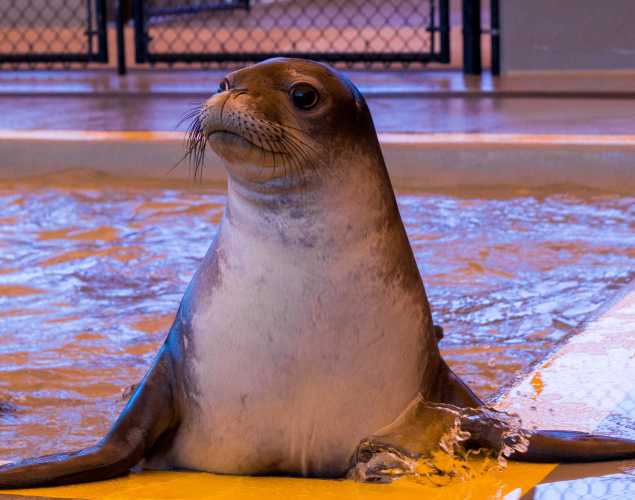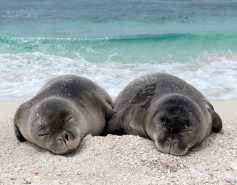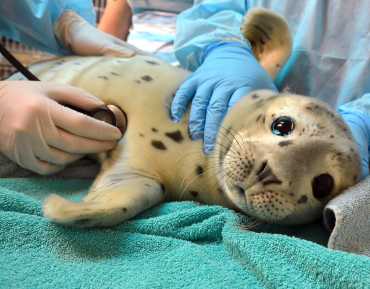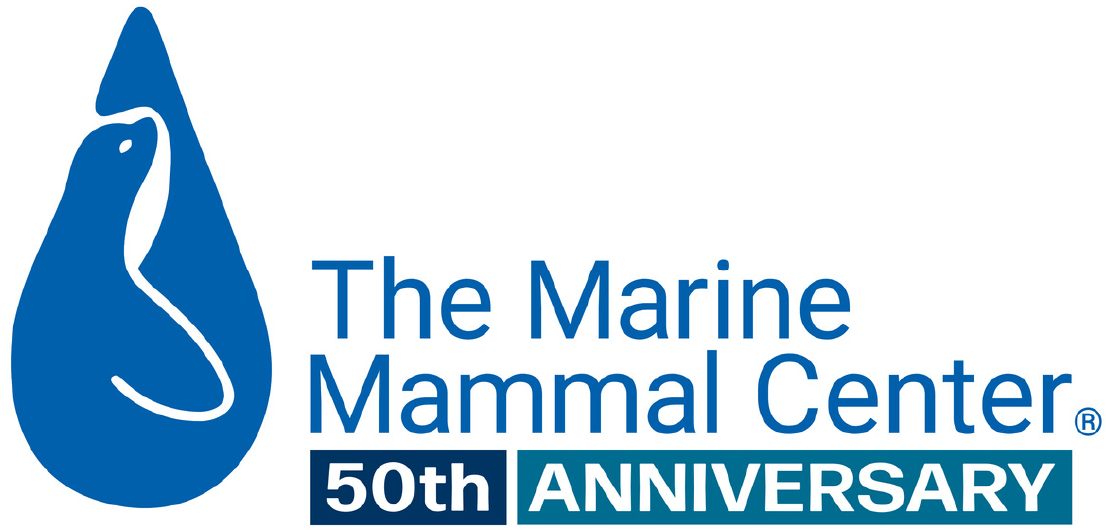
Hawaiian Monk Seal Pup Count Indicates Healthy Trend as Two New Patients Arrive at Ke Kai Ola
- Species conservation
Hawaiian monk seal births are on the rise, and our newly opened hospital, Ke Kai Ola, will help ensure that trend continues.
When the NOAA research vessel Oscar Elton Sette left the Big Island of Hawaii at the end of August, it was carrying four “fat and feisty” Hawaiian monk seals, Ke Kai Ola’s inaugural patients that were ready to be released back to their home in the Northwestern Hawaiian Islands.
When that same ship returned to shore after a 21-day research mission, it was carrying two new monk seal patients in need of help—as well as some good news: an increase in the number of monk seal pups born this season.
Scientists from NOAA’s Hawaiian Monk Seal Research Program counted 121 monk seal pups born this year, an increase compared to 103 pups last year and 111 pups in 2012. Preliminary numbers indicate that survival of young seals may be improving overall as well.
Many of the researchers who returned last week had been in the Northwestern Hawaiian Islands since June monitoring the monk seal population and helping improve survival when possible.
In many cases, this involves moving young seals from areas of low survival, such as Midway and Kure Atolls where just 25 percent of seals survive to age 3, to areas like Laysan Island where young seals have a 60 to 70 percent chance of survival.
Learn More About Hawaiian Monk Seals
{"image":"\/Animals\/Wild\/Hawaiian monk seal\/cropped-images\/HMS-wild-NOAA-4-832-3197-1474-1603733454.jpg","alt":"Two Hawaiian monk seals sleeping on the beach.","label":"Conservation","title":"Hawaiian Monk Seal Conservation","link_url":"\/science-conservation\/conservation\/hawaiian-monk-seal-conservation","type":"page"}

But every year, some pups are weaned prematurely and end up in such poor condition that they are unlikely to survive anywhere on their own. This was the case for two five-month-old pups that were found weighing less than half of what they should at their age.
Before we opened the doors of our Hawaiian monk seal hospital, these emaciated pups would have been left on the beach with an uncertain future. Now, thanks to people like you, these pups have a second chance at life.
Meleana (“continuous song”) and Pua ‘Ena O Ke Kai (“fiery child of the sea”)—or Mele and Pua, for short—are now rehabilitating under the watchful eye of Deb Wickham, Operations Manager at Ke Kai Ola. Recently dubbed “the unofficial pinniped matriarch of West Hawaii,” Deb ensures that Mele and Pua are fed three times a day and get any medications or treatments prescribed by veterinary staff.
Mele and Pua still face a long road to recovery, but both seals have already put on some weight. While Pua has been eating well on her own since arriving at Ke Kai Ola, Mele hasn’t figured out how to eat whole fish yet and must be tube-fed a smoothie-like mixture of ground-up fish to ensure she gets the nourishment she needs.
Deb and her team of trained volunteers are helping Mele learn how to catch fish during “fish school” sessions in which they use methods like dragging a fish on a string through the water to get her interested.
In between feedings, they’ll also be working on outreach efforts to help educate the local community about the endangered monk seals and the need for conservation. Video screens outside the hospital facility allow visitors to watch live footage of Mele and Pua without disturbing them.
The seal pups’ caregivers are also able to monitor their charges from a distance, part of an effort to reduce visual and physical contact during treatment. Dark mesh screens cover the fencing around Mele and Pua’s pens, and fish are thrown over the fence during feedings, limiting human interaction as much as possible.
It’s all part of an effort to ensure that Mele and Pua will one day be able to return to the Northwestern Hawaiian Islands. Perhaps they’ll even join their fellow Ke Kai Ola alums, Kūlia, Ikaika, Hāla‘i and Maka’ala, all of whom are being monitored via satellite tags and seem to be doing well.
Says Deb, “We want these pups to return home and thrive.”
Yes, I want to save a life!

Yes, I want to save a life!
You’ll be giving sick and injured animals the best possible care at the Center’s state-of-the-art hospital. With your gift today, you are giving a patient a second chance at life in the wild.
See Our Latest News
{"image":"\/Animals\/Patients\/Harbor seals\/2020\/cropped-images\/hs-barnwood-by-bill-hunnewell-c-the-marine-mammal-center-315-0-3299-2577-1607370547.jpg","alt":"harbor seal Barnwood","title":"Last-Minute Gift Guide \u2013 Top Gifts that Give Back to Marine Animals","link_url":"https:\/\/www.marinemammalcenter.org\/news\/last-minute-gift-guide","label":"News Update","date":"2025-12-18 01:00:00"}

Last-Minute Gift Guide – Top Gifts that Give Back to Marine Animals
December 18, 2025
Read More{"image":"\/Animals\/Patients\/Hawaiian monk seals\/2025\/cropped-images\/b-ru72admission-to-ke-kai-ola112125photo-c-the-marine-mammal-center-noaa-permit-24359-0-364-1270-992-1766095407.jpg","alt":"A newborn Hawaiian monk seal pup with a black coat in rehabilitative care.","title":"Newborn Hawaiian Monk Seal Pup Now Receiving Care","link_url":"https:\/\/www.marinemammalcenter.org\/news\/newborn-hawaiian-monk-seal-pup-now-receiving-care","label":"Patient Update","date":"2025-12-18 01:00:00"}

{"image":"\/Animals\/Patients\/Hawaiian monk seals\/2025\/cropped-images\/d-ru28release-exam-at-ke-kai-ola111025photo-by-giancarlo-rulli-c-the-marine-mammal-center-noaa-permit-24359-0-0-1270-992-1764620886.jpg","alt":"","title":"Bird Flu Vaccine Trial Offers Hope for Protecting Hawaiian Monk Seals","link_url":"https:\/\/www.marinemammalcenter.org\/news\/bird-flu-vaccine-trial-may-offer-hope-for-protecting-hawaiian-monk-seals","label":"News Update","date":"2025-12-01 08:13:00"}

Bird Flu Vaccine Trial Offers Hope for Protecting Hawaiian Monk Seals
December 1, 2025
Read More{"image":"\/Animals\/Patients\/Hawaiian monk seals\/2021\/hms-pp08-by-sheila-latta-c-the-marine-mammal-center-noaa-permit-18786.jpg","alt":"Hawaiian monk seal","title":"The New York Times: Inside the Bird-Flu Vaccine Trial for Monk Seals","link_url":"https:\/\/www.marinemammalcenter.org\/news\/the-new-york-times-inside-the-bird-flu-vaccine-trial-for-monk-seals","label":"In the News","date":"2025-12-01 01:00:00"}

The New York Times: Inside the Bird-Flu Vaccine Trial for Monk Seals
December 1, 2025
Read More
